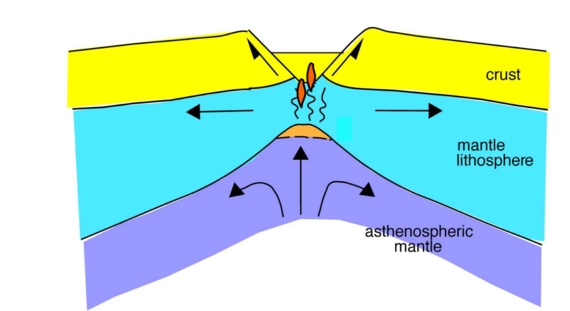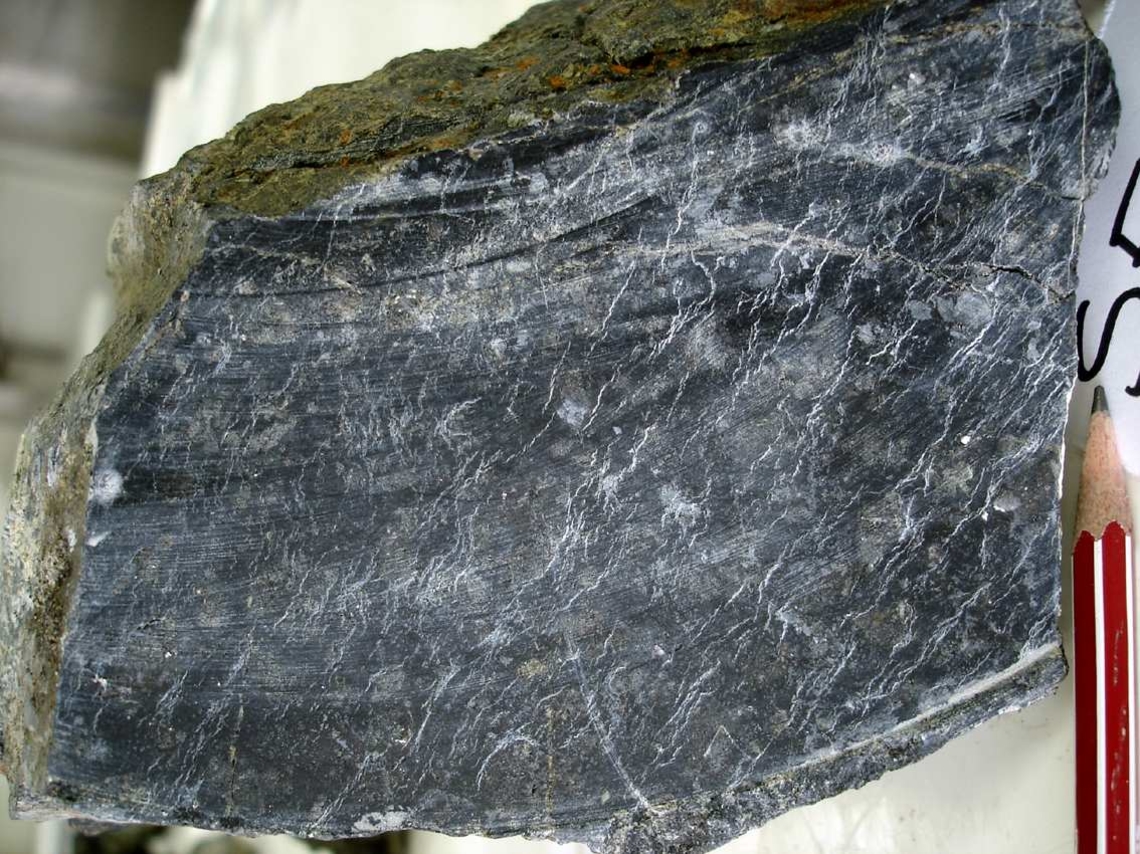Reaction Sea-water – Mantle: production of serpentine
Olivine, pyroxenes, spinels and peridotites
Eath's mantle comprises about 70% of the globe's mass. It extends over 2900 km between the crust and the nucleus. For the first 400 km, it is made of a mixture of minerals dominated by olivine, also called peridot. This assemblage of minerals is called peridotite.
The olivine is formed by a netword of silicon and oxygen atoms (we call this a silicate) on which magnesium atoms organize themselves, and, in lesser quantity, iron. Its formula is (Mg,Fe)2SiO4. Peridotites also contain in lesser amounts iron-magnesium silicates called pyroxenes, and oxides rich in chromium and aluminum called spinels.
© M.Cannat CNRS/IPGP
Schematic view of a slow-spreading ridge showing the large extension faults that form the walls of the axial valley et bring up the most superficial levels of the mantle. These superficial levels are called "lithospheric mantle" because the peridotites are relatively cold (less than 1000 °C) and stiff there. Below, we find the so-called "asthenospheric" mantle where the peridotites are warmer and softer.
The oceanic crust is thin (6 km or less) and is formed at the ridges' axis where the two plates spread apart. In the so-called "slow expansion rate" oceans, i.e. those whose opening rate is less than 3 or 4 cm/year, the spreading is accompanied by large extension faults that slice the crust and bring up the most superficial levels of the mantle.
In some areas of the Atlantic, these faults have such an off-set that they bring the peridotites all the way to the ocean floor.
When the sea-water that penetrates the crust reach the peridotites, it reacts with the olivine and the pyroxenes to form serpentine. This process is called serpentinization. When the peridotite is completely serpentinized, we call the rock a serpentinite.Serpentine is a magnesium silicate, rich in water, whose formula is: Mg3Si2O5(OH)4. Serpentine can also contain iron but in small amounts. The iron that is contained in the olivines and the pyroxenes is released during serpentinization and is used to form the so-called accessory minerals such as magnetite (an oxide of formula Fe3O4). We can also form some brucite, a hydrated oxide with the formula Mg(OH)2, which can contain iron as a partial replacement of magnesium. The production of magnetite from the extra iron uses oxygen from the water and is accompanied by the release of hydrogen. There are numerous possible serpentinization reactions. A typical reaction is given below.
Serpentinization reaction for the formation of serpentine, of small amounts of brucite and magnetite with a release of hydrogen. The bright color of the mineral in the peridotite is not real, it is the result of the observation under polarized light. Serpentine has a characteristic texture called honey-combs. The two microscope view have a width of approximately 0,2 millimeters.
Une serpentine
Campagne Serpentine 2007 - Mathilde Cannat
Scientists explore hydrothermal vents located on serpentinized peridotites on the sites Ashadze and Logatchev. These serpentinized peridotites have risen from the mantle through faults on the edge of the axial valley
They're looking for the products of the serpentinization reactions, and in particular hydrogen, in the hydrothermal fluids of these two sites.
Once back in the laboratory, they also study the chemistry of the minerals in the serpentinized peridotite samples, and try to determine the serpentinization reactions, the temperature conditions under which they occurred, and the chemistry of the hydrated fluid before and after these reactions. We also measure the density and magnetic properties of the samples, and analyze their deformation.
Serpentinization is accompanied by a release of heat: it is an exothermic reaction. The heat released by a complete serpentinization reaction of 1 kilo of peridotite is 250000 joules, enough to bring the temperature of 1 liter of water up by 50 degrees under normal temperature and pressure conditions.
Serpentinization is also accompanied by a change of the physical properties of the rock. The volume increases by up to 30%, with concomitant decrease of density. Serpentine is indeed a much less dense mineral than olivine and pyroxenes. A non serpentinized peridotite has a density of 3300 kg/m3 whereas a serpentinite has a density of approximately 2600 kg/m3.
In parallel, the speed of propagation of seismic waves decreases during serpentinization: from nearly 8 km/s in non serpentinized peridotites, to 5.5 km/s in serpentinites. The production of magnetite during serpentinization is accompanied by an increase of the rock's magnetic susceptibility, i.e. its ability to get magnetized. Finally, serpentine is less tolerant to deformation than olivine and pyroxenes. 15 to 20% of serpentine in a peridotite is enough to decrease the rock's tolerance to deformation and can specifically facilitate the motion on the faults.










